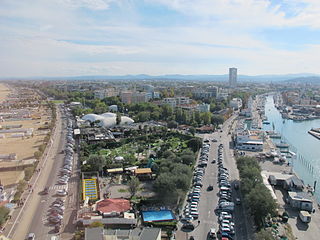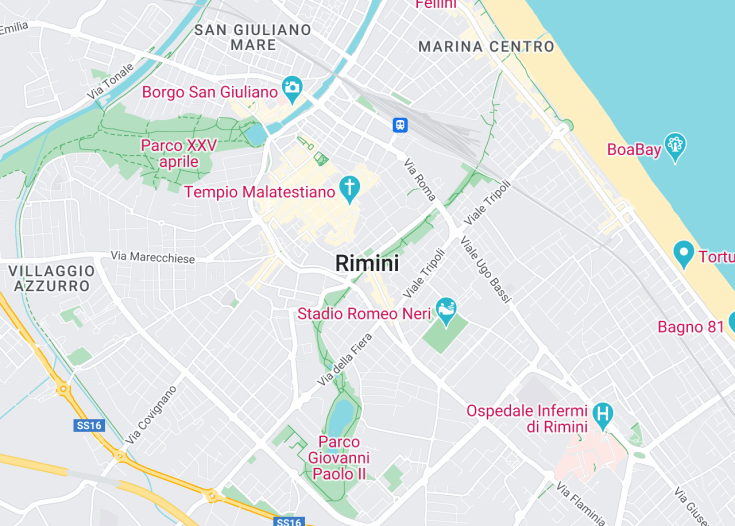Rimini, a gem on Italy’s Adriatic coast, offers a blend of vibrant beach life and rich historical heritage. Known for its lively nightlife and expansive sandy shores, Rimini also boasts significant ancient Roman and Renaissance monuments. Visitors can explore Tiberius Bridge and the Arch of Augustus or enjoy contemporary attractions like Italy in Miniature. The city’s culinary scene highlights local seafood and traditional Italian dishes, making it a perfect destination for both history buffs and beach lovers.
When in Rimini, consider renting a bike to explore its scenic promenade and historic sites comfortably and sustainably.
To fully experience local culture, visit during the “La Notte Rosa” festival, celebrated with concerts, fireworks, and pink-themed decorations.
Top things to do & see in Rimini
Select the following sights and activities to discover best tickets and tours available in Rimini.
Rimini: A Glimpse of Italy’s Timeless Charm
| Country | Italy |
| Time in Rimini | GMT+1 |
| Language spoken | Italian |
| Population | 150,576 (source: latest census data) |
| Currency | Euro (€, EUR) |
| Airports |
|
Rimini, a vibrant city located on the Adriatic coast of Italy, boasts a rich history dating back to ancient Roman times. Known as the hub of Italy’s Riviera, Rimini is a bustling tourist destination revered for its expansive beaches, historical sites, and dynamic nightlife. Its strategic position has historically made it one of the most important trading and communication routes in northern Italy and it has a rich cultural heritage, including significant Roman antiques like the Tiberius Bridge and the Arch of Augustus, which stand as proud reminders of its past.
Archaeological excavations have frequently revealed ancient artifacts, distinguishing Rimini as a historical treasure trove. In recent years, efforts to modernize the city while preserving its ancient structures have led to a harmonious blend of old and new, making Rimini an appealing destination for both historical enthusiasts and those seeking contemporary attractions.
The heart of Rimini’s vibrancy is its 15 kilometers of sandy beach which, during summer, is lined with beach resorts, restaurants, and nightclubs catering to all ages and tastes. Meanwhile, the city’s culinary scene offers an array of local seafood dishes, traditional Italian cuisine, and the unique blend of flavors that is only found in coastal cities.
Culturally, Rimini does not lag behind, hosting numerous festivals and events throughout the year, including the famous Rimini International Film Festival which draws cinema enthusiasts from across the globe. Its commitment to the arts can also be seen in its various museums and galleries, showcasing everything from contemporary art to archaeological collections.
Where is Rimini?
Rimini is situated along the northeastern coast of Italy, facing the Adriatic Sea.
Distances:
| Route | Distance by car | Time by car |
|---|---|---|
| Rome to Rimini | 223 miles | Approx. 4 hours |
| Milan to Rimini | 220 miles | Approx. 3.5 hours |
| Florence to Rimini | 90 miles | Approx. 2 hours |
What is Rimini famous for?
Rimini is renowned for its historical sites, long sandy beaches, and vibrant nightlife, making it a favorite resort destination among Europeans and international travelers alike.
History
Prehistoric to Roman Times (before 268 BC)
Archaeological findings suggest the area of Rimini has been inhabited since prehistoric times. It was later dominated by the Etruscans, followed by the Celts, and ultimately incorporated into the Roman Republic. Rimini, originally called Ariminum, was founded in 268 BC as a Latin colony used primarily as a strategic outpost on the Adriatic Sea to control the surrounding regions and as a pivotal point for roads like the Via Flaminia, connecting it directly to Rome.
Medieval Era (5th century – 14th century)
After the fall of the Roman Empire, Rimini faced numerous invasions but flourished under Byzantine rule in the early Middle Ages. In the mid-13th century, Rimini came under the control of the powerful Malatesta family, who ruled until the 1500s. Sigismondo Pandolfo Malatesta, one of its most notable lords, rebuilt the city into a Renaissance capital, enhancing its architecture and arts significantly during his rule.
Renaissance to Modern Era (15th century – 18th century)
After the Malatesta, Rimini was transiently held by various powers including the Papal States, Venice, and even becoming a part of the Cisalpine Republic during the Napoleonic era. This period fostered Rimini’s development as a cultural and economic hub in the region, albeit amidst constant political upheaval.
19th Century to Present
The 19th century saw Rimini become part of the newly unified Kingdom of Italy. In the 20th century, particularly during and after World War II, Rimini suffered significant damage but eventually emerged as a renowned tourist destination, famous for its beaches, historical sites, and vibrant nightlife. Today, Rimini stands as a testament to its rich historical tapestry intertwined with modern tourism and economic development.
Visit Rimini
What to see and do in Rimini, Italy
Explore the rich tapestry of history and vibrant contemporary lifestyle that Rimini offers. Visit key historical sites such as the Arch of Augustus, the oldest surviving Roman triumphal arch, and the Tiberius Bridge, an ancient Roman bridge that still spans the Marecchia River. The Tempio Malatestiano, restructured by Leon Battista Alberti during the Renaissance, houses exquisite art and serves as the burial site for members of the Malatesta family. For a taste of local life, stroll along the Marina Centro, Rimini’s bustling beachfront area, packed with bars, restaurants, and shops. The vibrant nightlife and luxurious beaches provide a perfect blend of relaxation and entertainment.
Events in Rimini
Rimini is not only about historical sights; it’s also a hub for vibrant festivals and events. The Rimini Meeting in August attracts thousands with its blend of cultural, political, and entertainment discussions. Not to miss is the Rimini Beach Festival, celebrated in summer, featuring music performances and various beach sports. Rimini also hosts the International Kite Festival every spring, where the skies are filled with colorful designs from around the world.
Best time to visit Rimini
The ideal time to visit Rimini is between late spring and early autumn, from May to September, when the weather is warm and conducive for beach activities and exploring the city’s historical landmarks.
Is Rimini worth visiting?
Rimini offers a compelling mix of ancient history, cultural depth, and modern-day leisure activities that make it a worthy destination. Its well-preserved Roman and Renaissance monuments, coupled with expansive sandy beaches and a lively cultural scene, provide something for every traveler. Whether you’re a history enthusiast, beach lover, or nightlife seeker, Rimini caters to all, making it undoubtedly worth visiting.









